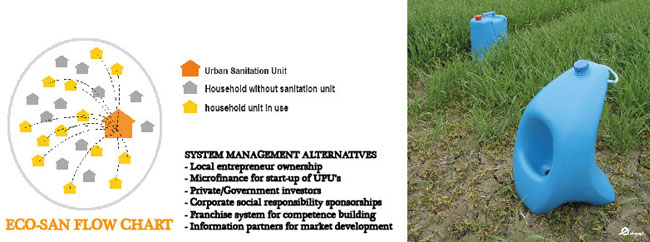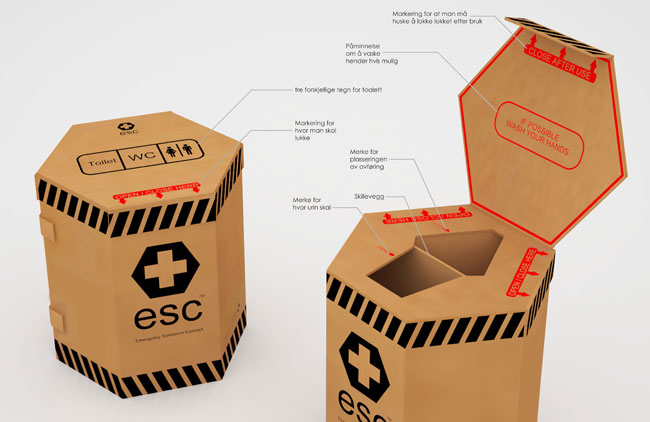ECOLOGICAL SANITATION SYSTEMS
Today, 2,6 billion people live without access to a toilet and even though the year 2008 was the United Nations Year of Sanitation, there is little attention and investment in this sector. Major effort is needed globally in order to create hygienic sanitation facilities for millions of people. Water latrines and sewerage systems like we find in western countries are not a good or sustainable solution for tight urban areas in the developing world. There is a need to develop cheap, technically viable and safe sanitation alternatives that can be used in different cultural and social settings. SUSAN-DESIGN is one of many organizations that are addressing this issue by developing ecological sanitation, including product design, processing technology and a viable business model. This method has been chosen as the methodology based on the possibility of bringing the nutrients back into the natural production cycle of food and animal fodder.
 A simple diagram of our metabolical life. What is crazy is how complex and energy consuming systems we have created in the last 100 years for ‘flush-and-forget- toilet infrastructures and for the production of food. The situation today is such that we can not sustain it longer nor develop globally. Last year for the first time more than 50% of the population on earth lives in urban areas and this will increase over the next decades. This system addresses food production and discharge.
A simple diagram of our metabolical life. What is crazy is how complex and energy consuming systems we have created in the last 100 years for ‘flush-and-forget- toilet infrastructures and for the production of food. The situation today is such that we can not sustain it longer nor develop globally. Last year for the first time more than 50% of the population on earth lives in urban areas and this will increase over the next decades. This system addresses food production and discharge.
The goal of the project is to create “a production unit producing safe and hygienic soil improvement agent and fertilisers for agricultural use with human waste”. (from SUSAN-DESIGN project text)
I have followed the SUSAN-DESIGN gang for some time. I met Karsten Gjefle, the leader of the project in the Norwegian Design Centre’s section named: Design Without Borders where we worked a bit together. The start up of the project has taken some time. One of the reasons is that the issue has not been popular in the media. People are not interested in this problem and issues like access to water, hunger, over-population and global warming have taken the lead. It is not to devalue those problems, but public awareness of the huge problems with sanitation and hygiene is limited.
SUSAN-DESIGN has initially been concentrating on a twofold pilot project in Uganda: urban slums in Kampala and schools. This is a very interesting project, dealing with the technicality of the product, the business model so that running toilet services makes a profit and organic agriculture.
 An image showing the Uganda project and a simple mobile toilet designed by the Norwegian designer Sarah Keller.
An image showing the Uganda project and a simple mobile toilet designed by the Norwegian designer Sarah Keller.
Now they have developed a new product for instant ecological toilet systems in crisis areas, like Haiti at the moment. The model is the same for working with the shit and piss (in separate systems) how to transport it and process so that it becomes a safe and good fertilizer for organic agriculture.
 An instant toilet made of cardboard designed by Norwegian designer Jan Kristian Strömnes. It is flat-pack and can be sent in large volumes fast. As can be seen in the image the toilet has separate containers where bags for the shit and piss are placed, then transported to a system that processes organic fertilizers.
An instant toilet made of cardboard designed by Norwegian designer Jan Kristian Strömnes. It is flat-pack and can be sent in large volumes fast. As can be seen in the image the toilet has separate containers where bags for the shit and piss are placed, then transported to a system that processes organic fertilizers.
Sustainability.
But the greatest argument for SUSAN-DESIGN is that it addresses issues of environmental sustainability. The ideal of the system is to create a closed system for our life cycle, where we do not rely on extremely expensive and unattainable water toilet systems like used in our western world and incredibly energy demanding production of artificial fertilizers for food productions. Organic living, harmony with nature is fundamental while the business model should also generate profit. The Triple Bottom Line evaluation methodology is the basis of the philosophy of SUSAN-DESIGN. I ask everyone to study the projects and to promote it in the media.
And if you happen to be in Copenhagen on the 29th of June next go and visit this Designers Talk - Design to Improve Life
 June 18, 2010
June 18, 2010
 Tags: crisis, DESIGN, disaster, ecological, slums, urban Posted in: DESIGN, PONDERINGS
Tags: crisis, DESIGN, disaster, ecological, slums, urban Posted in: DESIGN, PONDERINGS

